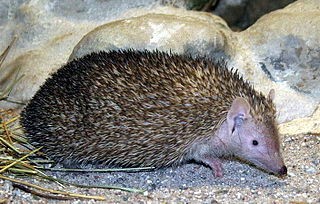
Oreopanax is a genus of shrubs and trees in the family Araliaceae, comprising circa 85 species native to the Americas.

The lesser hedgehog tenrec is a species of mammal in the family Tenrecidae.
Oreopanax arcanus is a species of plant in the family Araliaceae. It is found in Guatemala and Mexico. It is threatened by habitat loss.
Oreopanax candamoanus is a species of plant in the family Araliaceae. It is endemic to Peru.
Oreopanax cissoides is a species of plant in the family Araliaceae. It is endemic to Peru.
Oreopanax corazonensis is a species of plant in the family Araliaceae. It is endemic to Ecuador. Its natural habitat is subtropical or tropical moist montane forests. It is threatened by habitat loss.
Oreopanax grandifolius is a species of plant in the family Araliaceae. It is endemic to Ecuador. Its natural habitat is subtropical or tropical moist montane forests. It is threatened by habitat loss.
Oreopanax impolitus is a species of plant in the family Araliaceae. It is endemic to Ecuador. Its natural habitat is subtropical or tropical moist montane forests. It is threatened by habitat loss.
Oreopanax ischnolobus is a species of plant in the family Araliaceae. It is endemic to Peru.
Oreopanax jelskii is a species of plant in the family Araliaceae. It is endemic to Peru, Bolivia and Ecuador.
Oreopanax klugii is a species of plant in the family Araliaceae. It is endemic to Peru.
Oreopanax lehmannii is a species of plant in the family Araliaceae. It is endemic to Ecuador. Its natural habitats are subtropical or tropical moist montane forests and subtropical or tropical high-altitude shrubland. It is threatened by habitat loss.
Oreopanax lempiranus is a species of plant in the family Araliaceae. It is endemic to the Parque Nacional Montaña de Celaque in the occidente of Honduras. The plant is known in Spanish as the "arbol del oro del cacique lempira" for the golden colored trichomes on the leaf and the significance of the native chief Lempira in the region.
Oreopanax peltatus is a species of plant in the family Araliaceae. It is found in Guatemala and Mexico. It is threatened by habitat loss.
Oreopanax raimondii is a species of plant in the family Araliaceae. It is endemic to Peru.
Oreopanax rosei is a species of plant in the family Araliaceae. It is endemic to Ecuador. Its natural habitats are subtropical or tropical moist montane forests and subtropical or tropical high-altitude shrubland. It is threatened by habitat loss.
Oreopanax sanderianus is a species of plant in the family Araliaceae. It is found in Guatemala, Honduras, and Mexico. It is threatened by habitat loss.
Oreopanax sessiliflorus is a species of plant in the family Araliaceae. It is endemic to Ecuador. Its natural habitats are subtropical or tropical moist montane forests and subtropical or tropical high-altitude shrubland. It is threatened by habitat loss.
Oreopanax stenophyllus is an evergreen shrub or treelet in the family Araliaceae. It is endemic to cloud forests on the eastern slopes of the Peruvian Andes, between 2800 and 3700 meters above sea level.

Tenrecinae is a tenrec subfamily endemic to the island of Madagascar. It contains the largest species in the family, Tenrec ecaudatus. All members of the genus possess spines, analogous to those of hedgehogs, for defense against predators.


